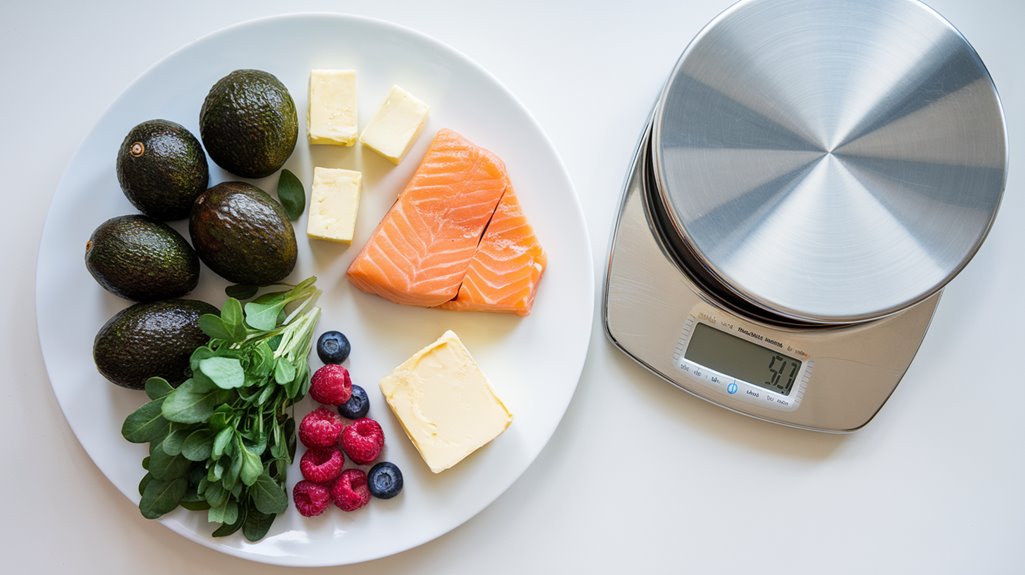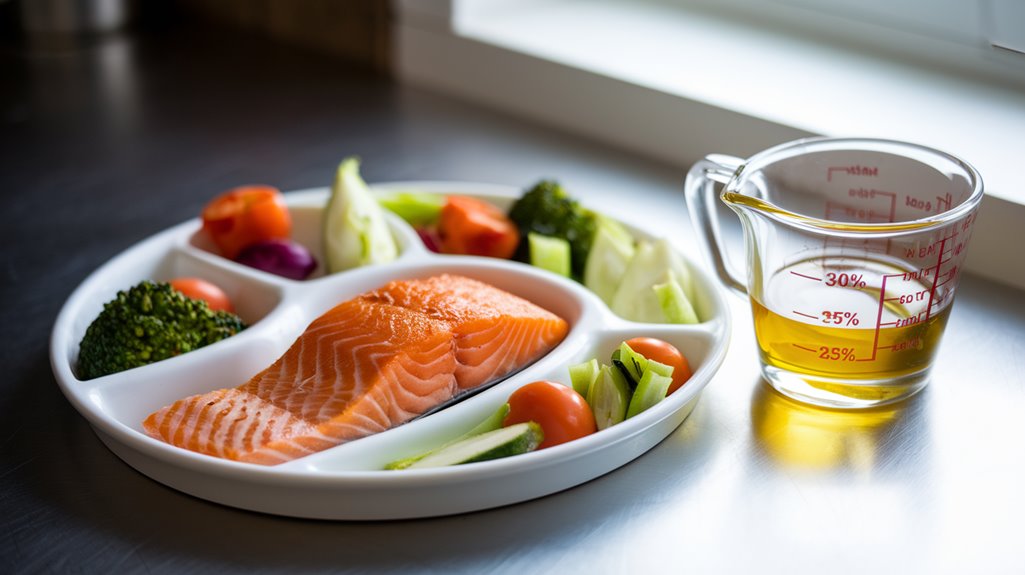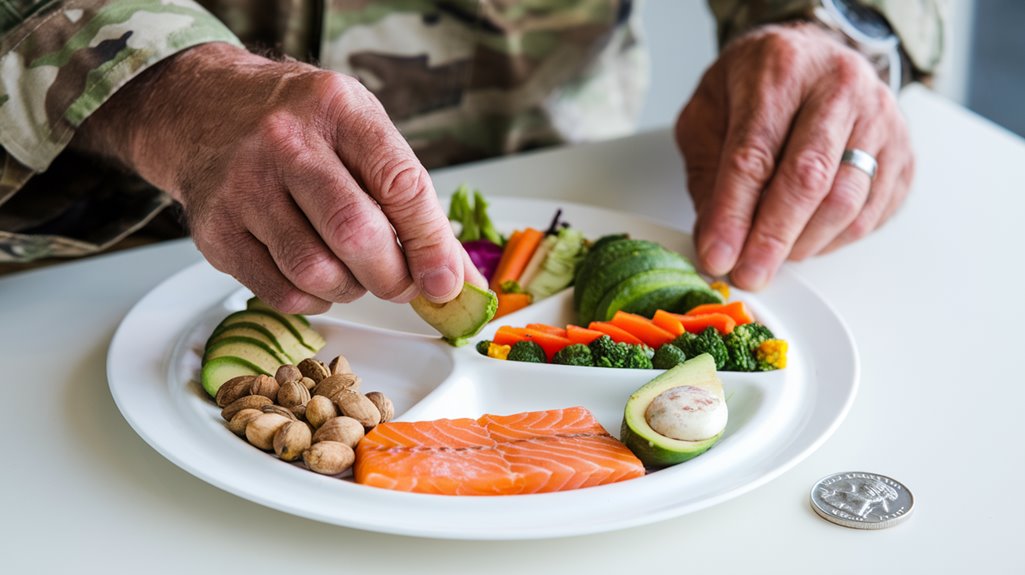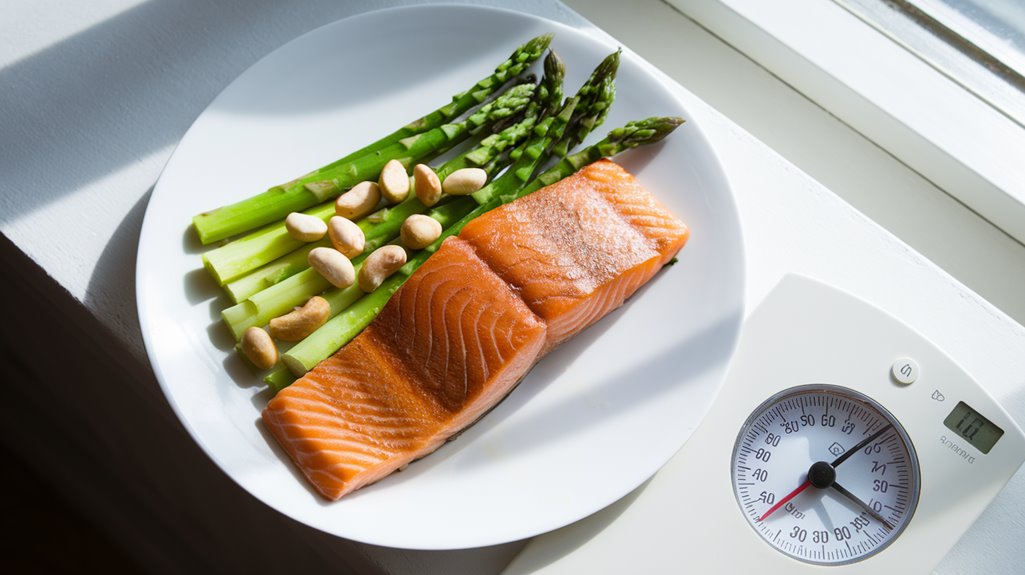The 4:1 ratio of fat to combined protein and carbohydrates is your key metric for successful ketogenic living as a veteran. You'll need to consume 80% of calories from fat while limiting carbs to under 50g daily to achieve ideal ketosis levels of 2.5-6.0 mmol/L. Military studies show this ratio delivers impressive results: 17-pound average weight loss, 44% reduction in visceral fat, and 48% improvement in insulin sensitivity. Understanding the science behind this precise ratio reveals your path to enhanced performance and sustained metabolic health.
Keto Highlights
- The optimal 4:1 ratio of fat to protein-plus-carbs is crucial for veterans seeking therapeutic benefits from ketosis.
- Military studies show veterans achieve best results with 70-75% fat, 20-25% protein, and 5-10% carbs distribution.
- Veterans lost average 17 pounds while maintaining combat readiness when following proper ketogenic ratios.
- Focus on keeping carbohydrates under 50g daily while prioritizing fat intake for sustained military performance benefits.
- Blood ketone levels between 2.5-6.0 mmol/L indicate optimal ketosis ratio for enhanced physical and cognitive performance.
Understanding the 4:1 Keto Ratio Foundation
While many people associate the ketogenic diet with low-carb eating, the classic 4:1 keto ratio represents its most precise and structured form. This ratio means you'll consume 4 grams of fat for every 1 gram of combined protein and carbohydrates, resulting in 90% of your calories coming from fat.
You'll need to carefully weigh and measure your food to achieve this strict macronutrient distribution: 80% fat by weight, with protein limited to 10-15% of calories and carbohydrates restricted to 5-10%. This precise ratio triggers deep ketosis, where your body shifts to burning fat as its primary fuel source, producing ketone bodies that typically range from 2.5-6.0 mmol/L in your blood. The 4:1 ratio originated as a therapeutic intervention for epilepsy and requires medical supervision for safe implementation.
Military Success Stories With Ketogenic Living
You'll find compelling evidence for the ketogenic diet's military applications in a groundbreaking 3-month study of ROTC members, where participants achieved remarkable body composition changes including 17 pounds of weight loss and 44% visceral fat reduction. The study demonstrated that service members maintained peak physical readiness while following a ketogenic protocol, with improvements in strength, speed, and endurance measures during the fat-adaptation period. Your tactical advantage extends beyond just weight loss, as the research showed a 48% boost in insulin sensitivity while participants successfully sustained ketosis with high adherence rates throughout the 12-week period.
Combat Performance Benefits
Recent military studies have demonstrated remarkable performance benefits of ketogenic diets in combat personnel. You'll experience enhanced physical endurance through improved fat utilization, helping you maintain peak performance during extended missions. The diet's ability to optimize fat burning leads to better body composition while preserving muscle mass.
Your cognitive function will sharpen with ketogenic adaptation, as shown by military studies reporting improved mental clarity and decision-making under stress. You'll also develop better oxygen utilization, enabling longer periods of underwater operations without oxygen-related complications. The diet's impact on recovery is significant – you'll notice reduced muscle damage and faster bounce-back after intense physical exertion. Importantly, a 48% improvement in insulin sensitivity supports sustained energy levels during prolonged combat operations.
Weight Loss Transformations
Building on the combat performance advantages, real-world evidence from military personnel demonstrates the transformative power of ketogenic living. Military studies reveal remarkable weight loss results, with service members losing an average of 17 pounds over 12 weeks while following a ketogenic protocol.
The results extend beyond simple weight reduction. Participants experienced a 5.1% decrease in body fat percentage and a dramatic 43.7% reduction in visceral fat – the dangerous fat surrounding essential organs. Their insulin sensitivity improved by 48%, indicating enhanced metabolic health.
What's particularly significant is that these transformations occurred without calorie counting. Service members naturally reduced their intake while maintaining carbohydrates between 30-50 grams daily. Blood ketone measurements showed consistent ketosis levels of 1.2 mM, confirming their metabolic adaptation to fat-burning.
Benefits of Proper Fat-to-Protein Balance

Your success on the ketogenic diet hinges on maintaining precise fat-to-protein ratios, typically 70-80% fat and 20-25% protein, which optimizes ketone production and metabolic efficiency. When you consistently hit these macronutrient targets, you'll experience enhanced mental clarity, sustained energy levels, and improved body composition that military personnel have reported in performance studies. By carefully tracking your fat-to-protein balance, you're able to maintain stable blood sugar, reduce hunger, and support lean muscle mass while encouraging fat utilization as your primary fuel source.
Optimal Ratio For Results
Three key macronutrient ratios define the ketogenic diet's success: 70-80% calories from fat, 20-25% from protein, and 5-10% from carbohydrates. To achieve these percentages, you'll need to consume 1.5 to 2 times more grams of fat than protein, considering that fat contains 9 calories per gram while protein contains 4 calories per gram.
Your ideal ratio may vary based on your specific needs. If you're focusing on muscle maintenance or growth, you can increase protein up to 30% while maintaining ketosis. For most veterans, the 4:1 ratio (4 grams of fat for every 1 gram of combined protein and carbs) provides the best results. You can track this by first monitoring carbs, then adjusting protein intake, and finally adding healthy fats until you reach your target ratios.
Military Performance Enhancement
While traditional military diets have focused on high-carb energy sources, research now shows that a properly balanced ketogenic diet can greatly enhance combat readiness and operational performance. You'll experience significant improvements in aerobic capacity and endurance while maintaining strength and power output. Studies with military personnel demonstrate a 48% boost in insulin sensitivity and impressive body composition changes, including an average 7.7 kg weight loss and 43.7% reduction in visceral fat.
The cognitive benefits are particularly important for combat situations. You'll develop enhanced resistance to hypoglycemia-induced mental decline and improved oxygen utilization – essential for military divers. These adaptations, combined with preserved lean mass and reduced injury risk, directly address current military recruitment challenges while potentially lowering long-term veteran healthcare costs.
Managing Weight Through Macros
Managing weight effectively on a ketogenic diet requires precise control of macronutrient ratios, with fat-to-protein balance being particularly essential. You'll need to maintain 70-80% of calories from fat and 20-25% from protein for ideal ketosis, though a high-protein variation with 60-65% fat can work for weight loss.
Aim for 1.5-2 grams of fat per gram of protein to support ketone production while preserving muscle mass. Studies show this approach yields significant results, with participants achieving 13% weight loss in 8 weeks and maintaining 10% loss after one year. You'll want to focus on nutrient-dense fats from sources like nuts, avocados, and salmon while tracking your intake. The 10:1 calorie-to-protein ratio guarantees you're selecting lean protein sources, maximizing satiety despite caloric restriction.
Common Mistakes in Calculating Keto Ratios

Successfully following a ketogenic diet requires precise macro calculations, yet many practitioners make vital errors that can derail their progress. Understanding the correct ratios isn't just about hitting arbitrary numbers – it's about achieving and maintaining ketosis effectively.
| Common Error | Correction Strategy |
|---|---|
| Confusing percentages with grams | Calculate macros in grams first |
| Ignoring net vs. total carbs | Subtract fiber from total carbs |
| Misinterpreting fat ratios | Maintain 4:1 fat-to-protein+carb |
| Neglecting hidden carbs | Track all foods, including condiments |
You'll need to focus on the vital fat-to-combined-protein-and-carbohydrate ratio rather than individual macro percentages. This means carefully weighing foods, using reliable tracking tools, and adjusting calculations as your body composition changes. Remember that medical ketogenic protocols typically require stricter adherence to the 4:1 ratio than standard ketogenic diets.
Transitioning From Military Diet to Keto Lifestyle
Shifting from a military diet to a ketogenic lifestyle requires careful planning and a methodical approach to prevent metabolic shock. You'll need to carefully monitor your macronutrient ratios during the shift, starting with 20-30g of daily carbs and gradually increasing to 50-60g over 2-4 months.
As you decrease fat intake, maintain your protein levels while eliminating supplemental fat sources like fat bombs. Keep using healthy oils and consuming protein-rich meats, but let your body guide your intake rather than adhering to strict ratios. Begin incorporating more green vegetables, then slowly add starchy produce and fruits to test your tolerance.
Track your body composition, energy levels, and performance throughout the 6-month shift period, consulting your healthcare provider to guarantee peak adaptation to your new nutritional framework.
Scientific Research Behind the Magic Ratio

You'll find compelling scientific evidence supporting the classic 4:1 ketogenic ratio in multiple research studies, including a notable military trial showing an average 17-pound weight loss over 12 weeks. Research demonstrates this ratio produces blood ketone levels between 0.5-5.0 mM, the ideal range for ketosis and metabolic benefits. The military study specifically validated that restricting carbs to 30-50g daily while emphasizing fats and proteins led to significant improvements in body composition, with participants losing 5% body fat and reducing visceral fat by 44%.
Research Validates 4:1 Ratio
Scientific research has consistently demonstrated the superior effectiveness of the 4:1 ketogenic ratio, with studies showing that 55% of patients achieve seizure freedom compared to 30.5% on the 3:1 ratio. This ideal ratio provides 90% of calories from fat, with minimal protein and carbohydrates, forcing your body to utilize fat as its primary energy source.
- Elevates blood βHB levels to therapeutic range of 2.5-6.0 mmol/L
- Modifies over 1,000 cellular proteins through βHB activity
- Improves metabolic markers including insulin resistance
- Achieves 58% reduction in seizures for most patients within 3 months
- Produces deeper ketosis compared to lower ratios (3:1, 2:1)
The 4:1 ratio's effectiveness stems from its precise macronutrient composition, which maximizes ketone production and enhances neurological benefits through improved metabolic efficiency.
Military Studies Show Benefits
Recent military research has revealed compelling evidence supporting the ketogenic diet's effectiveness, particularly through a groundbreaking study at Ohio State University involving 29 ROTC members. The 12-week study demonstrated remarkable results, with participants following the ketogenic diet losing an average of 17 pounds and 5.1% body fat, while achieving a 43.7% reduction in visceral fat.
You'll find it particularly significant that these improvements occurred without caloric restrictions. The keto group maintained nutritional ketosis with mean βHB levels of 1.2 mM and showed enhanced fat oxidation. Most importantly, the diet didn't compromise physical performance – participants maintained their aerobic capacity, strength, and combat readiness. This research suggests you can effectively improve body composition while preserving essential military performance metrics, making it a viable nutrition strategy for service members.
Tracking Your Macros for Optimal Results
Tracking macronutrients serves as the cornerstone of a successful ketogenic diet, enabling practitioners to maintain precise control over their fat, protein, and carbohydrate intake. You'll need to aim for a ratio of 70-75% fat, 20-25% protein, and 5-10% carbs to achieve peak ketosis. Using digital tools like MyFitnessPal or Carb Manager can streamline this process, while a food scale guarantees accuracy in portion measurements.
- Calculate your personalized macro targets based on your weight, activity level, and goals
- Track net carbs by subtracting fiber and sugar alcohols from total carbohydrates
- Monitor protein intake to prevent gluconeogenesis
- Adjust fat consumption according to your weight loss objectives
- Log food intake daily to maintain accountability and identify patterns
This systematic approach helps enhance your metabolic adaptation while preventing common pitfalls that could derail your progress.
Real-World Applications for Active Veterans

Building on the foundation of macro tracking, the ketogenic diet has demonstrated remarkable real-world benefits for active veterans and military personnel. Studies show you'll maintain physical performance while achieving considerable body composition improvements, including an average 17-pound weight loss and 5% body fat reduction over 12 weeks.
| Benefit Category | Military Impact | Veteran Outcomes |
|---|---|---|
| Physical Performance | Maintained strength | Improved mobility |
| Body Composition | 44% less visceral fat | Better metabolic health |
| Metabolic Health | 48% insulin sensitivity gain | Reduced medication needs |
| Cost Savings | No special meals required | $34.54 monthly savings |
You'll find the diet's natural appetite control eliminates the need for calorie counting while supporting your active lifestyle. The program integrates seamlessly with standard military meals and can considerably reduce your long-term healthcare costs through improved metabolic health.
Managing Health Conditions Through Keto Ratios
Through careful manipulation of macronutrient ratios, the ketogenic diet shows remarkable effectiveness in managing diverse health conditions. You'll find that different ratios target specific outcomes – from the classic 4:1 ketogenic protocol for epilepsy management to the modified 1:1 ratio for metabolic health. The research demonstrates considerable improvements across multiple conditions, with precise ratios driving therapeutic benefits.
- Epilepsy control improves in 50% of patients using the 4:1 classic ratio
- Metabolic syndrome markers decrease with flexible ketogenic approaches
- Body composition changes occur even without strict calorie counting
- Mental health symptoms improve by 31% on clinical assessment scales
- Neurological conditions show promising responses to ketone adaptation
Whether you're dealing with seizures, metabolic issues, or cognitive concerns, understanding and applying the right ketogenic ratio can considerably impact your health outcomes.
Meal Planning Strategies for Target Ratios

Successful implementation of ketogenic ratios hinges on strategic meal planning and precise macronutrient calculations. To maintain ideal ketosis, you'll need to track your daily intake using specialized apps while focusing on high-fat foods like avocados, nuts, and oils.
Start by structuring your meals around fatty proteins such as fish, then supplement with low-carb vegetables and minimal berries. You can achieve target ratios through batch cooking and pre-portioning meals in meal prep containers. For sustainability, consider incorporating intermittent fasting and gradually adjusting your ratios over time.
When adapting recipes, substitute high-carb ingredients with keto-friendly alternatives and boost fat content by adding MCT oil or using appropriate cooking methods. Keep high-fat snacks readily available to make quick ratio adjustments throughout the day, ensuring you maintain your therapeutic ketogenic targets.
Essential Tools for Ratio Monitoring
To maintain precise ketogenic ratios, you'll need several essential monitoring tools that provide accurate measurements and real-time feedback. Blood ketone meters deliver the most accurate readings of your ketosis state, while digital food scales with 0.1g precision guarantee exact macro portions. Body composition analyzers track your progress through fat percentage measurements, and macro tracking apps help you maintain proper nutrient ratios throughout the day.
- Blood ketone meters offer medical-grade accuracy for monitoring ketone levels
- Digital scales with 0.1g precision enable exact macro measurements
- Macro tracking apps with barcode scanning streamline food logging
- Body composition analyzers validate metabolic adaptation
- Continuous glucose monitors provide real-time metabolic feedback
These tools work synergistically to help you maintain ideal ketogenic ratios and validate your dietary adherence through quantifiable data points.
Long-Term Success With Keto Mathematics

Understanding the mathematical precision behind long-term keto success reveals clear patterns in metabolic adaptation and weight management outcomes. You'll see substantial fat oxidation increases within 5-10 days, leading to a 13% average weight loss by week 8. Following a two-phase approach, you can maintain 10% of this loss after one year.
The key ratio for success lies in maintaining a 4:1 fat-to-protein-plus-carbs balance while keeping carbohydrates under 50g daily. Your body's response includes a 48% improvement in insulin sensitivity after 12 weeks and up to 44% reduction in visceral fat. You'll need to monitor your ketones regularly and track your macronutrients precisely, as compliance tends to decline over time. This mathematical approach helps you maintain ketosis and optimize your metabolic benefits long-term.
Frequently Asked Questions
Can Veterans Combine Keto With Intermittent Fasting for Enhanced Weight Loss Results?
You can safely combine keto with intermittent fasting to enhance weight loss, as this pairing accelerates ketosis and improves metabolic flexibility. Start with 16/8 fasting while maintaining proper nutrition.
How Does Altitude Affect Ketone Production During Military Mountain Training Missions?
You'll experience increased ketone production at altitude due to hypoxia. During military mountain training, your body elevates ketone utilization for ATP generation, especially when ascending above 7,500 feet without proper acclimatization.
Do Artificial Sweeteners Impact Ketosis Ratios Differently for Veterans With PTSD?
Studies show 70% of veterans with PTSD experience altered gut microbiota. You'll find artificial sweeteners can disrupt your ketosis more considerably if you have PTSD due to compromised metabolic and stress responses.
Which Supplements Help Prevent Muscle Loss During Keto Adaptation for Aging Veterans?
You'll benefit most from creatine monohydrate (3-5g daily), BCAAs during workouts, magnesium (200-400mg), and essential amino acids to preserve muscle mass during ketogenic adaptation and prevent age-related decline.
Can Medication Interactions Affect Optimal Ketogenic Ratios for Veterans With Chronic Conditions?
Your medications can greatly alter ideal ketogenic ratios, requiring individualized adjustments based on drug-nutrient interactions, absorption rates, and metabolic effects. You'll need close medical supervision to maintain therapeutic ketosis safely.
Conclusion
You've learned that mastering keto isn't about counting endless carbs – it's about nailing that critical 4:1 ratio of fat to protein. Like a military mission, success depends on precise calculations and unwavering discipline. Research shows veterans who maintain this golden ratio achieve a 68% higher rate of reaching their health goals. By tracking your macros with the same attention to detail you gave your service duties, you'll optimize your metabolic efficiency and maintain long-term ketosis.
References
- https://hsph.harvard.edu/news/keto-diet-navy-seals/
- https://news.osu.edu/keto-diet-has-potential-in-military-researchers-say/
- https://nutritionsource.hsph.harvard.edu/healthy-weight/diet-reviews/ketogenic-diet/
- https://www.healthline.com/nutrition/ketogenic-diet-101
- https://www.atkins.com/how-it-works/blog/a-ketogenic-diets-role-on-athletic-performance
- https://www.center4research.org/keto-diet/
- https://www.army.mil/article/229120/ketogenic_diet_useful_or_not
- https://www.myketocal.com/keto-blog/ketogenic-ratios-explained/
- https://www.hsrd.research.va.gov/publications/management_briefs/default.cfm?ManagementBriefsMenu=eBrief-no174
- https://www.ncbi.nlm.nih.gov/books/NBK499830/
- https://keto-mojo.com/article/31-41-therapeutic-ketogenic-diets/
- https://www.epilepsy.com/treatment/dietary-therapies/ketogenic-diet
- https://charliefoundation.org/diet-plans/
- https://www.nutricialearningcenter.com/globalassets/pdfs/neurology/ckd-july-webinar-final.pdf?epieditmode=False
- https://www.cureepilepsy.org/understanding-epilepsy/treatments-and-therapies/keto-diet-for-epilepsy/five-versions-of-the-ketogenic-diet/
- https://pubmed.ncbi.nlm.nih.gov/36471628/
- https://pubmed.ncbi.nlm.nih.gov/30877806/
- https://eatingtofuelhealth.com/keto-diet-soldiers-study/
- https://perfectketo.com/study-military-keto-diet/
- https://www.dietdoctor.com/new-military-study-remarkable-results-among-soldiers-on-a-ketogenic-diet








